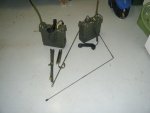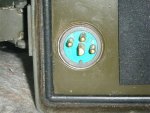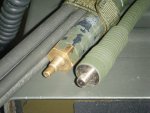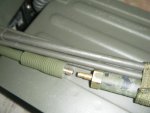Do you have a battery to look at? Many of the batteries have the pinout and voltages printed on them.
If not, and you are looking at the pins on the bottom of the radio, they are set up like this:
- The big "D" pin is only for orientation, no connections to it.
- The pin following the "D", as if it were the letter "O" in the word "DO", is common connection for both the filament voltage (A-) and the high voltage (B-)
- The pin "above" the D (at about 1200 noon position) is the positive 14.5 volts, A+
- The pin above but behind the "D" (at about 1100 o'clock) is the filament voltage positive, A+.
The pins are the same whether it's a PRC-25 or a PRC-77. The '77 just doesn't use the filament tap. Your radio should say on the tag if it's a '25 or a 77. If it doesn't, then you have to look inside to know. I don't have a '25 so can't tell you where the tube is.
As for the antenna, I don't know what brass part you are referring to. Can you tell us the model number of the long multi-section antenna you have?
The short tape antenna screws into it's flex section, then into the radio. The antenna is the AT-892, the flex section typically says P/O AT-892 (part of AT-892). No, the flex section won't hold up the long whip.
The long whip you have might be the AT-271. It has an adapter on the bottom that fits the radio, or fits the spring. Is that thread adapter what you are calling the brass part? With the adapter it should screw into the radio, but should be used with it's spring section.
[edit: there is another adapter made for the AT-271 that is 3/8-24, not the 5/16x24 of the radio. Bet that's what's going on]
One other thing to know: The radio has to 'know' which antenna is screwed in, either the short one or the long one. It 'knows' that by how far the antenna screws into the radio. There's a switch down in the bottom of the threaded hole that gets pushed down by the long antenna so the transmitter output gets proper matching. So, the screw threads of the long antenna have to be longer, or there will be a skinny probe sticking out of the bottom of the threads on the long antenna to push the switch.
BTW, the newer AB-1036 antenna has a sliding switch device on it to tell the radio how long it is, and can be used either long or short by collapsing the telescoping sections.
There's good info on PRC68.com describing the different threads, 5/16 x 24 tpi, or 3/8" x 24 tpi.
Bob WB4ETT
Just a quick 2 questions for the guru's,I have heard of the
D plug for the battery,is there a way to test it with a
regular home style meter.I want to know if it is a 25or
a 77.I thought the prc-77 just had a positive and negative
post?
I want to make sure I order the right DC cord and batt.
pack from prc.68.com
I have looked in my manuals,but I find them confusing.
Which of the three small post and one large centre one
is positive and negative?
Also, I am trying to figure out the long folding stick antenna,
it threads into the long brass piece,but not the top of the radio.
Do I need to thread it into the top of the flex end of the
tape antenna,it doesn't support the weight,also,do I need
to use the brass part?
Thanks
![Thumbs Up [thumbzup] [thumbzup]](https://www.steelsoldiers.com/images/smilies/icon_smile_thumzup.gif)
![Thumbs Up [thumbzup] [thumbzup]](https://www.steelsoldiers.com/images/smilies/icon_smile_thumzup.gif)






